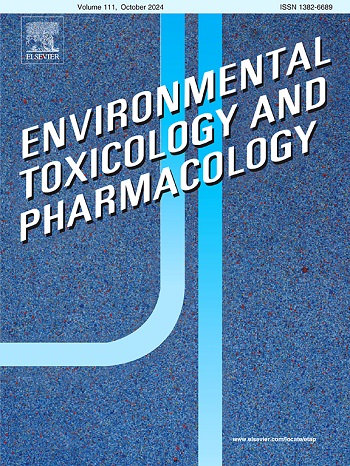Environmental co-exposure to lead and cadmium induces species-specific genotoxic stress responses in free-ranging rodent zoomonitors
IF 4.2
3区 环境科学与生态学
Q2 ENVIRONMENTAL SCIENCES
引用次数: 0
Abstract
The ecotoxicological multi-species and bioassay approach is used to compare the effects of chronic lead and cadmium co-exposure on genomic stability in free-ranging rodent zoomonitors. Heavy metal accumulation, a biomarker of exposure, and DNA damage, a biomarker of genotoxic effects, were analyzed using the comet assay (for early effects) and the micronucleus test (for irreversible effects). Significant site- and species-specific differences in lead and cadmium liver levels were observed. All rodents exhibited a positive, dose-dependent genotoxic response. Toxicant-induced DNA damage significantly correlated with elevated lead but not cadmium loadings. Among the rodents studied, Apodemus flavicollis exhibited the strongest sensitivity to lead- and cadmium-induced genotoxicity in situ, followed by Microtus arvalis and Mus macedonicus. Therefore, A. flavicollis is likely the most appropriate zoomonitor when assessing DNA integrity during genotoxicity monitoring. The presence of micronuclei and DNA damage in free-ranging rodents can serve as reliable and accurate indicators in genotoxicity risk assessment.
环境共同暴露于铅和镉诱导物种特异性基因毒性应激反应在自由放养啮齿动物监测员。
生态毒理学多物种和生物测定方法用于比较慢性铅和镉共同暴露对自由放养啮齿动物基因组稳定性的影响。使用彗星试验(用于早期效应)和微核试验(用于不可逆效应)分析重金属积累(暴露的生物标志物)和DNA损伤(基因毒性效应的生物标志物)。观察到肝脏铅和镉水平的显著地点和物种特异性差异。所有啮齿动物均表现出阳性的剂量依赖性基因毒性反应。毒物诱导的DNA损伤与铅含量升高显著相关,而与镉含量升高无关。对铅和镉原位遗传毒性的敏感性最高的是黄仓鼠,其次是小仓鼠和马其顿家鼠。因此,在遗传毒性监测中评估DNA完整性时,黄杆菌可能是最合适的动物监测仪。散养鼠类中微核和DNA损伤的存在可作为遗传毒性风险评估的可靠、准确的指标。
本文章由计算机程序翻译,如有差异,请以英文原文为准。
求助全文
约1分钟内获得全文
求助全文
来源期刊
CiteScore
7.00
自引率
4.70%
发文量
185
审稿时长
34 days
期刊介绍:
Environmental Toxicology and Pharmacology publishes the results of studies concerning toxic and pharmacological effects of (human and veterinary) drugs and of environmental contaminants in animals and man.
Areas of special interest are: molecular mechanisms of toxicity, biotransformation and toxicokinetics (including toxicokinetic modelling), molecular, biochemical and physiological mechanisms explaining differences in sensitivity between species and individuals, the characterisation of pathophysiological models and mechanisms involved in the development of effects and the identification of biological markers that can be used to study exposure and effects in man and animals.
In addition to full length papers, short communications, full-length reviews and mini-reviews, Environmental Toxicology and Pharmacology will publish in depth assessments of special problem areas. The latter publications may exceed the length of a full length paper three to fourfold. A basic requirement is that the assessments are made under the auspices of international groups of leading experts in the fields concerned. The information examined may either consist of data that were already published, or of new data that were obtained within the framework of collaborative research programmes. Provision is also made for the acceptance of minireviews on (classes of) compounds, toxicities or mechanisms, debating recent advances in rapidly developing fields that fall within the scope of the journal.

 求助内容:
求助内容: 应助结果提醒方式:
应助结果提醒方式:


